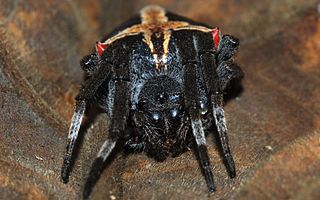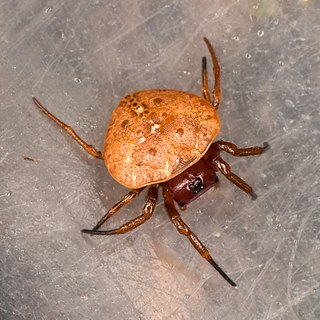| Micrathena | |
|---|---|
 | |
| Micrathena sagittata in Virginia, USA | |
| Scientific classification | |
| Kingdom: | Animalia |
| Phylum: | Arthropoda |
| Subphylum: | Chelicerata |
| Class: | Arachnida |
| Order: | Araneae |
| Infraorder: | Araneomorphae |
| Family: | Araneidae |
| Genus: | Micrathena Sundevall, 1833 [1] |
| Type species | |
| Micrathena aureola (C. L. Koch, 1836) | |
| Species | |
119, see text | |
| Synonyms [1] | |
Micrathena, known as spiny orbweavers, is a genus of orb-weaver spiders first described by Carl Jakob Sundevall in 1833. [5] [6] Micrathena contains more than a hundred species, most of them Neotropical woodland-dwelling species. The name is derived from the Greek "micro", meaning "small", and the goddess Athena. [7]
Contents
Species with extremely long spines evolved at least eight times in the genus Micrathena and likely function as anti-predator defenses. [8] Gasteracantha orb-weavers also have hardened abdomens with variously shaped spines, but they are not closely related to Micrathena within the orb-weaver family. [9]
These spiders are active during the daytime and build vertical orb webs. Unlike many other orb-weavers, members of Micrathena bite their prey before wrapping it. When laying eggs, females will place the egg sac on vegetation near the web. [5]













